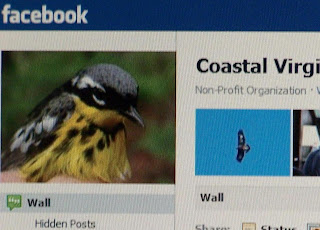

Welcome to the Coastal Virginia Wildlife Observatory blog for postings of programs, activities and photos of unusual birds and butterflies around Virginia. To LEARN more about our nonprofit work, SUBSCRIBE to our monthly newsletter, and SUPPORT us, visit our website at www.vawildliferesearch.org. "Protecting Wildlife through Field Research, Education and Habitat Conservation for Over 25 Years"
Sharp-shinned Hawk

Sharp-shinned Hawk, by Steve Thornhill
Friday, December 23, 2011
Happy Holidays!

Wednesday, December 21, 2011
LeConte's Sparrow
Tuesday, December 20, 2011
Selasphorus Hummingbird
Wednesday, November 30, 2011
Friday, November 11, 2011
Wednesday, November 9, 2011
Final Results for Prothonotary Warbler Boxes in Chesapeake, VA

Stephen Living, VaDGIF Wildlife Biologiest, or I, plus volunteers from CVWO, Williamsburg Bird Club, and Historic Rivers Chapter of VA Master Naturalists, visited Northwest River Park 22 times between April 13 and July 5 – sometimes twice a week – to ensure that as many nestlings and adults as possible were counted and banded. Here are the final numbers:
- 136 PROW nestlings banded
- 17 new PROW females captured and banded
- 3 new PROW males captured and banded
- 55 boxes showed evidence of PROW nest activity (from "sprig of moss" to 2 broods)
- 6 boxes had 2 broods that were banded
- 9 female PROW females banded at Northwest River in 2009 and 2010 were “recaptured” in 2011. Five were banded as adults in 2009; one was banded as a nestling in 2009; three were banded as adults in 2010.
Many thanks to the organizations who provided start-up supplies, labor, and financial support for this 2011 effort:
- Coastal Virginia Wildlife Observatory
- VA Department of Game and Inland Fisheries
- Virginia Society of Ornithology
- Richmond Audubon Society
- Williamsburg Bird Club and individual Bird Club members
- Members of Historic Rivers Chapter, VA Master Naturalist
We’re looking forward to mid-April 2012 when the first Prothonotary Warblers arrive!! Stay tuned.
Wednesday, November 2, 2011
Golden Eagle at Kiptopeke
Tuesday, October 25, 2011
Leucistic Red-tailed
Saturday, October 15, 2011
Gulf Fritillary
Wednesday, October 12, 2011
Trying to Look Like a Stick
Sunday, October 2, 2011
ANOTHER Unusual Gull




Unusual Gull


Tuesday, September 20, 2011
Swainson's Hawk at Kiptopeke

Sunday, September 11, 2011
Friday, August 12, 2011
White M Hairstreak
Thursday, July 28, 2011
Red Phalarope
Thursday, July 21, 2011
Thursday, June 23, 2011
Purple Martin Youngsters
Wednesday, June 15, 2011
Prothonotary Warbler Update


Since the end of April, Stephen Living and I have banded 59 PROW nestlings, and 18 adults – 3 males and 15 females. A male PROW and newly banded nestling (complete with fecal sac) shown in above photos.
Friday, June 10, 2011
Thursday, June 2, 2011
College Creek Hawkwatch Season Ends

Sunday, May 15, 2011
Sandhill Cranes and White-winged Dove at College Creek
Brian Taber
Tuesday, May 3, 2011
New Season Record at College Creek Hawkwatch
Brian Taber
Tuesday, April 26, 2011
Prothonotary Warblers at Northwest River


Carolina Chickadees are early breeders and we found 9 CACH nests, most with eggs and two boxes with nestlings. April 25 was the birthday for one clutch of 5 and the other box had 4 nestlings 4 days old.
Twenty-four of the older boxes showed evidence of Prothonotary Warbler nest building – everything from 1” of moss to a complete nest with three eggs! Another nest had one egg. The eggs are creamy white with dark brown speckles. The nests are a combination of moss and cypress twigs, usually 2-3 inches of each with the cypress twigs on the top layer. We observed one PROW female approach a box with nesting material and another flew out of a box as we approached. Incidentally we observed a good size watersnake curled up on a limb nearby!
New boxes installed in mid-March are not seeing much activity – except from wasps. We did hear PROW singing near these boxes, but not in the quantity we observed in the area of the established boxes where we heard or saw a PROW near almost every box. We’ll see what happens to these new boxes as the nesting season progresses.
Saturday, April 16, 2011
Prothonotary Warbler box update at Northwest River Pk



The Prothonotary Warbler boxes at Northwest River Park in Chesapeake are open and ready for birds to move in. And a few have taken us up on the offer.
April 13 and 14, Steve Living and I along with three volunteers, Les Lawrence, Janet Lockwood, and Geoff Giles, checked over 80 boxes by motorized canoe and discovered 9 Carolina Chickadee nests (no nestlings yet), one Prothonotary Warbler nest, and quite a few wasp nests. Male Prothonotary Warblers are definitely back in Virginia – seen and heard everywhere along the box trail.
This citizen science project is supervised by Dr. Bob Reilly, Master Bander and VP of CVWO and Professor in the Center for Environmental Studies at VCU, with assistance from Steve Living, Wildlife Biologist with VA DGIF and Shirley Devan, Williamsburg Bird Club and Historic Rivers Chapter, VA Master Naturalist.
Above is a photo of the Prothonotary Warbler nest found April 14, constructed with cypress twigs. Also, a photo of Steve Living driving the boat and "happy" Les Lawrence installing “false fronts” on the boxes to help us capture male Prothonotary Warblers later in the season as they feed the nestlings.
Sunday, April 3, 2011
Big Day at College Creek Hawkwatch

Sunday, March 20, 2011
1,000th Bird at College Creek

Saturday, March 12, 2011
Prothonotary Boxes at Northwest River


Brian Taber
Monday, February 28, 2011
College Creek Hawkwatch Feb Summary



Thursday, February 10, 2011
College Creek Hawkwatch Begins

























